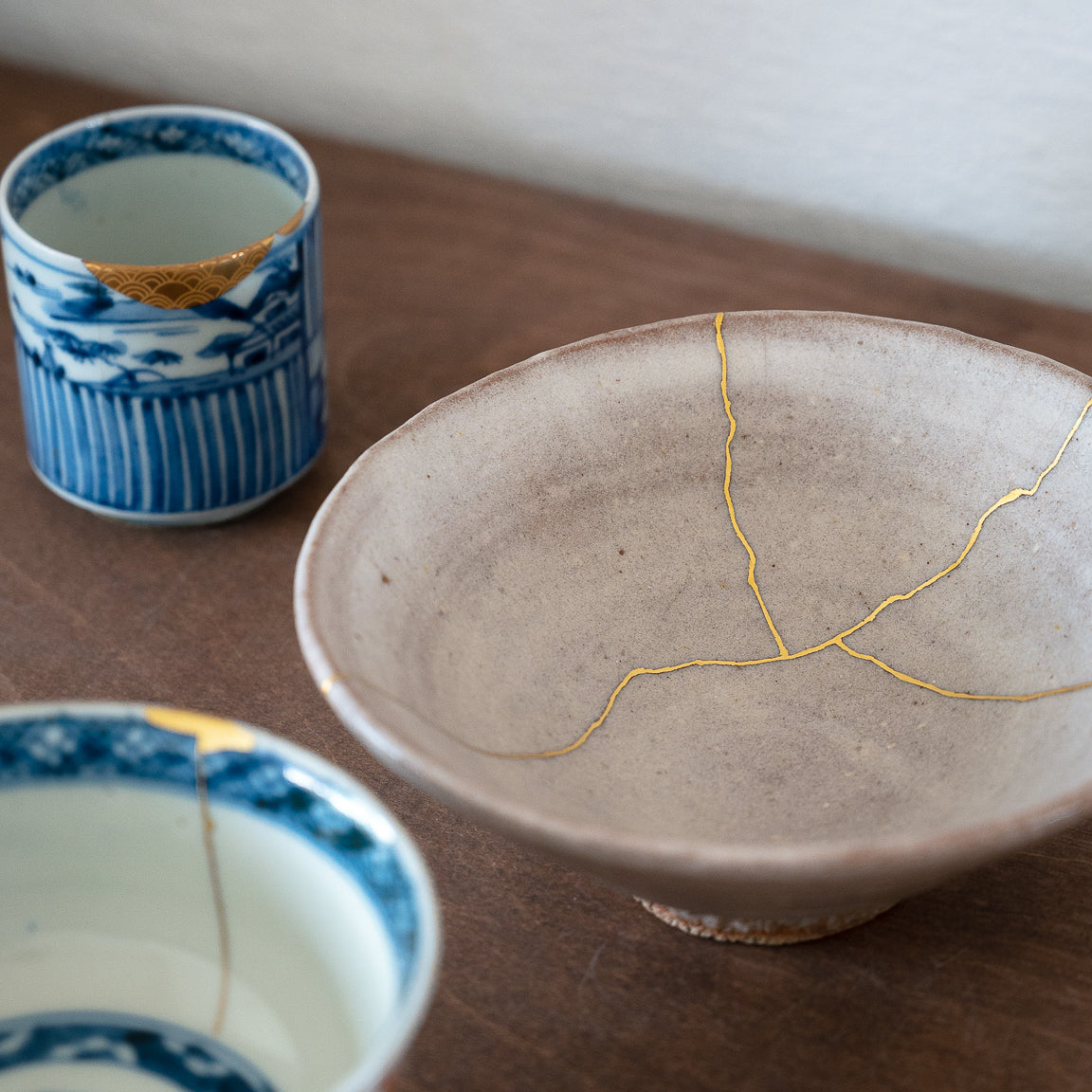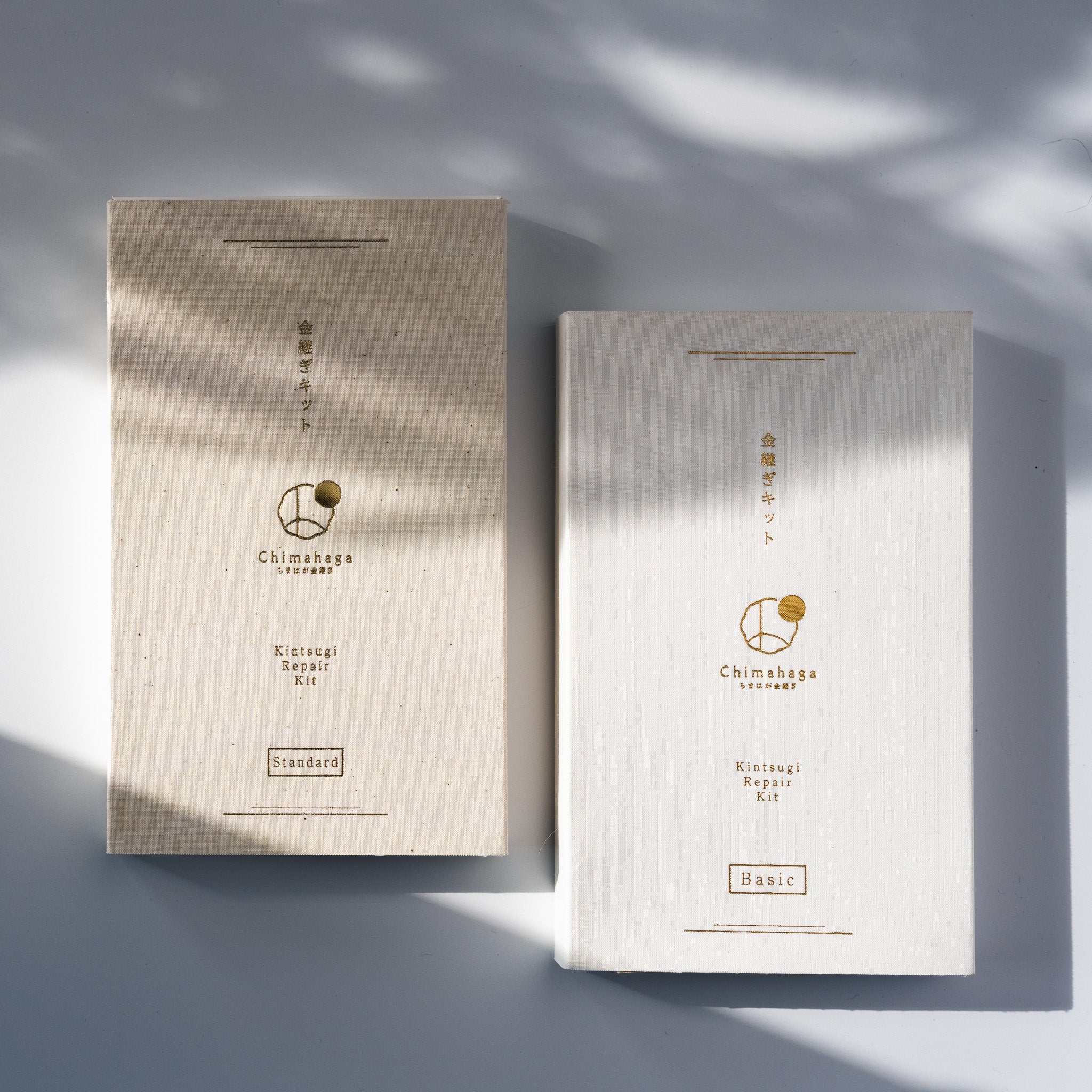Kintsugi is a technique of decorating the seams caused by repairing broken ceramics with gold.
However, kintsugi can actually be divided into various types.
First, let's briefly review the kintsugi procedure.
Kintsugi mainly consists of the following processes:
- The process of "repairing" a broken piece of ceramics to a state in which it can be used again.
- The process of "decorating" the repaired sears with gold.
Depending on what kinds of materials are used in these processes, the types of kintsugi are also divided.
In other words, the types of kintsugi can be classified in terms of the following two aspects:
- What kind of materials are used for the repair.
- What is used to decorate the seam.
1. Classification by Materials Used in Repair
First, we will discuss the aspect of "1. What kind of materials are used for the repair”.
The main point of contention here is whether or not to use “Urushi”.
From this perspective, kintsugi can be classified into the following two major categories:
a. Using urushi (Traditional Kintsugi)
b. Without using urushi (Modern Kintsugi)
Let's look at them one by one.
a. Using urushi (Traditional Kintsugi)
Urushi has long been used in traditional Japanese Kintsugi.
Urushi is a natural resin that becomes extremely hard when hardened, and once hardened, it is harmless to the human body, which is why it has long been used as a robust repair material.
Because urushi can also be used as a paint, it has been used in Japanese craft decoration since ancient times, and over its long history, techniques have been established to achieve delicate and beautiful finishes.
Traditional Kintsugi using urushi can achieve a beautiful finish that resembles craftsmanship through the use of these techniques.
However, it has the disadvantages of causing a rash if touched during the work and taking several days to harden.
To compensate for this disadvantage, "Modern Kintsugi" has been developed in recent years.
b. Without Urushi (Modern Kintsugi)
In "Modern Kintsugi," the urushi used in the traditional kintsugi procedure is replaced by synthetic resins or commercially available adhesives.
For example, the following substitutions are common patterns:
- Use glue or epoxy resin instead of urushi in the process of gluing broken pieces together.
- Epoxy resin is used instead of urushi to fill in chipped areas.
- Synthetic resin paint is used instead of urushi in the process of coating the sears.
There are many other patterns, but the common point is that urushi is replaced by something else.
Advantages include no rash and a shorter curing time.
Disadvantages include concerns about safety when used as tableware and a lack of beauty in finishing.
(Nevertheless, if the work is carefully done by the method of gluing with epoxy resin and coating with synthetic resin paint, it is possible to make it look so good that it cannot be distinguished at a glance from the work done with urushi.)
2. Classification by Finishing Material
Next, let's look at the classification by finishing material.
Gold powder is mainly used to decorate the seams, but what is used to decorate the seams also determines the type of Kintsugi.
The following are just a few of the typical types:
a. Pure gold powder
a-1 Keshifun
a-2 Marufun
b. Alternative gold powder
b-1 Brass powder
b-2 Mica powder
c. Finishing other than gold
c-1 Silver powder finish
c-2 Urushi finish
a. Pure Gold Powder
Pure gold is often used in traditional kintsugi.
Although the repair is inevitably more expensive because real gold is used, gold does not rust and can achieve a luster that cannot be obtained with other materials.
The types of pure gold powders used in kintsugi can be mainly divided into "keshifun" and "marufun" according to the particle size.
a-1 Keshifun

Keshifun is a very fine-grained pure gold powder made from pure gold leaf that has been ground into powder form.
When used in kintsugi, a certain degree of luster can be achieved simply by applying it to the seams using a cotton ball.
Compared to marufun, it is easier to work with and recommended for beginners, so we also include keshifun in the kits we sell in our online store.
a-2 Marufun

Marufun has larger particles than keshifun.
Since finishing with a cotton ball alone produces almost no luster, it is necessary to sand the surface of marufun to bring out the luster.
Although marufun has larger particles than keshifun, the absolute particle size is still quite fine, so it requires a certain amount of skill to polish it beautifully.
It is not suitable for beginners, but it can produce a metallic luster that cannot be obtained with keshifun.
The larger particles than keshifun also have the advantage of being less prone to wear in daily use.
b. Alternative Gold Powders
Alternative gold powders are often used in modern kintsugi.
"Alternative" means that pure gold is not used.
Instead of expensive pure gold, "brass powder" or "mica powder," which are similar in appearance, are often used.
b-1 Brass Powder
Brass is a metal that is a mixture of copper and zinc.
It can achieve a color and luster similar to keshifun.
However, unlike pure gold, it rusts over time and the color of the seams will gradually dull.
b-2 Mica Powder
Mica is originally a natural mineral, but in modern kintsugi, artificially produced mica is used in powdered form.
It has a golden color, but its luster and color are different from pure gold.
c. Finishing with Materials Other Than Gold
In fact, kintsugi can be finished with materials other than gold.
There are various finishing methods, such as "Gin-tsugi" when finished with silver, and "Urushi-tsugi" when finished with urushi.
c-1 Silver Powder
Silver powder is used to do "Gintsugi".
As with gold powder, there are pure silver powders and alternative powders such as tin, and keshifun and marufun are also available.
However, unlike pure gold, silver tarnishes over time, so if you want to keep its appearance, you can finish it with platinum.
c-2 Urushi Finish
As the name implies, the seams are finished by applying urushi of the desired color.
When hardened, urushi becomes a robust, water-resistant coating film that can be used in daily life.
Another advantage is that since no metal is used, urushi finished pieces can be used in microwave ovens.
Conclusion
Although I have introduced a lot of information, I think that the following two points will basically cover the general framework:
- Whether to use urushi for repair or not
- What kind of gold powder is used for finishing
Especially for those who would like to start kintsugi from now on, it would be better to check the materials used in the class you are going to attend or the kit you are going to purchase from these two points of view to avoid any mismatches.


